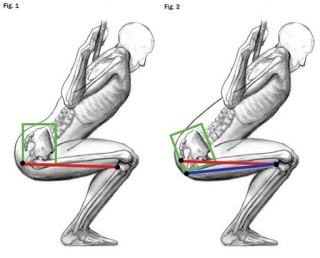When it comes to squatting, there seems to be only 2 mindsets.
1. “Squats are bad for the knees and back.”
2. “MOAR SQUATZ.”
Chance are if you are on this site, you already have mindset #2. Many people have a fear of squats that is caused by inexperience and incorrect advice from uneducated individuals. They have been told that squatting (especially squatting with thighs below parallel) puts a tremendous amount of force on the knees and lower back, which will inevitably lead to serious injuries.
All followers of Lift Big Eat Big know that this is simply not the case, and is in direct opposition of the truth. According to my wife, besides “protein”, “squat” is the word I repeat the most throughout the day. This is because I have to repeat myself daily to remind individuals that when performed correctly, squats are the best exercise you can do for your body.
The National Strength and Conditioning Association (NSCA) released a statement regarding their position on the safety and effectiveness of the squat. Below is a snapshot of the 9 bulletpoints of their position:
According to author Rob Faign, “there is a perverse situation prevailing in gyms across America: People are doing the right exercise (squats) the wrong way (half-way down) for the right reason (to protect their knees).” Half squats are also popular with bodybuilders who are seeking to develop large quadriceps instead of a strong posterior chain.
By halting the squat half or quarter of the way down, the knees are forced to absorb the movement midway through. By squatting to full depth, the movement reaches its natural finishing point, and the knees are assisted out of the bottom by the hamstrings and glutes. Not only are deep squats not bad for the knees, but without deep squats your knees will be left in a very weakened state.
Deep squats will strengthen hamstrings, hips, glutes, and every other muscle you possess, whereas half squats focus primarily on the quadriceps (which, as we all know, is a glamour muscle).
 |
|
| Proper lumbar curve on left, “butt wink” on right. |
One of the issues that can arise with new recruits is the infamous “butt wink”, or the posterior tilt of the pelvis at the bottom of a squat. This by itself doesn’t present any real dangers to the spine, but it can be an indicator of improper form. A few ways to fix this issue is driving the knees out, keeping the chest up and open, and making to sure not over-extend the lumbar, which can put it in a weakened position.
In closing, there are just a few things to remember, which I have outlined in a chart that is easy to remember:




What's a tampon bar?
look at those dumb shoes, that dummy is wearing.
Tampons are those pads pussies use… ;p (Pads on the bar)
those shoes are great for squatting
The silly cushion put on the bar to not hurt their back
That's when I knew I had to change gyms. When I saw the bar padded and there was no chalk. Pussies.
Converse or VANS, both perfect for squats & deads
What is your stance on "Bulgarian Split Squats?" As effective? There is no squat rack (other than a smith machine) at my gym.
Change gyms
Thanks once again to Crossfit cultists everywhere who blindly follow Rippetoe into the abyss, the "butt wink" has taken center stage.Butt wink is not a surefire sign of lumbar flexion.John Broz (who knows a think or two about squatting and weightlifting), is adamant that butt wink is not an issue. I'll trust that man.So go ahead, try to mobwod that buttwink away instead of working on being a man and squatting more than 315. I'll be in the corner of the gym, squatting man weights, and winking my butt the whole time.
John Broz has some great ideas and I agree with most of them. I did not find any information on his opinion concerning the "butt wink" issue. Please post a reference so I can read it for myself.
The article explicitly states that a buttwink does not pose any danger to the health of the spine.
I squat without shoes, any advice on that matter?
Do a control+F search for "butt wink" on this YouTube comments page:http://www.youtube.com/all_comments?v=3xFm9q1HBKY&page=2
"Butt wink is not a surefire sign of lumbar flexion." vs. "it [butt wink] can be an indicator of improper form." Obviously these two statements are miles apart! Sigh…Just as a note, Greg Everett has similar views regarding this.
I do the same when I forget to put on my chucks.